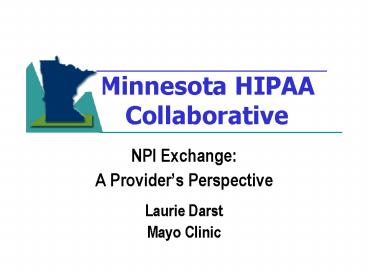Minnesota HIPAA Collaborative - PowerPoint PPT Presentation
1 / 13
Title:
Minnesota HIPAA Collaborative
Description:
Payer should send a list of existing group numbers maintained in their database ... that might be needed for reimbursement (i.e. zip code, taxonomy code, etc) ... – PowerPoint PPT presentation
Number of Views:52
Avg rating:3.0/5.0
Title: Minnesota HIPAA Collaborative
1
Minnesota HIPAA Collaborative
- NPI Exchange
- A Providers Perspective
- Laurie Darst
- Mayo Clinic
2
Exchange-Who, Why, What, How
- Who Payers
- Priority 1 (Highest risk category) Contact all
payers who currently assign legacy group
numbers and legacy individual numbers - Contact top 20 payers which represents 80 of our
claim volume - Contact our clearinghouse to determine how they
will handle incoming and outgoing NPIs - Next Step communicate to all other payers
3
Exchange-Who, Why, What, How
- Why Ensure Payment Continuity
- NPIs will replace all existing payer assigned
legacy numbers and - Providers chose how they want their subparts
enumerated therefore - Granularity of subpart NPIs can have payer
reimbursement implications - Payers need to cross-map their legacy numbers to
NPIs (many to one one to many situations)
4
Exchange-Who, Why, What, How
- What - Needs to be Exchanged
- Type I (Individual Providers)
- One to One match (most payers)
- Type II (Organizations and Subparts)
- Many times not a One to One match
- Providers should communicate/collaborate with
payers their Type II NPI-to-Legacy ID
relationships prior to exchange file
5
Exchange-Who, Why, What, How
- Type II NPI to Legacy Relationship Communication
- Determine subpart enumeration schema
- Identify payers who currently assign legacy group
numbers and determine gaps - Payers currently requiring more granularity in
enumeration - Payers who would need to process additional
numbers - Determine whether there are contract implications
changing granularity
6
Exchange-Who, Why, What, How
- Type II NPI to Legacy Relationship Communication
- Payer should send a list of existing group
numbers maintained in their database to be
matched with the numbers a provider submits
resolve discrepancies - Review subpart schema with payer address claim
data elements that might be needed for
reimbursement (i.e. zip code, taxonomy code, etc)
7
Exchange-Who, Why, What, How
- How Exchange Mechanisms
- Different methods of NPI exchange may be required
based on payer (i.e. Web, Excel file, ENUF,
paper) - Some payers indicate they will do their crosswalk
on the fly with Type I NPIs based on submitted
claims - Can your billing system accommodate dual number
submission? - Will your vendor deliver their NPI solution
timely enough so adequate time is allowed for
payers to do their crosswalk on the fly? - Many organizations were planning to populate
their systems from the NPPES system
8
Exchange-Who, Why, What, How
- How To Begin Process for Exchange
- Develop project plan for exchange and testing
process - Determine what is expected by each payer
- Check payer web sites and watch payer bulletins
- Contact payers directly
- Monitor MN Collaborative Web Site
9
Exchange-Who, Why, What, How
- Questions to Have Answered
- Payer contact info
- Determine how currently paid by payer (tax id or
legacy number) - Exchange options both Type I and II
- What data elements are necessary
- Payers system readiness to accept NPI
- Will there be new paperwork required
10
Exchange-Who, Why, What, How
- Additional Questions to Have Answered
- When will the payer be ready to accept claims
with NPIs (test and production timelines) - Does payer plan to use taxonomy codes
- Will payer provide remit (end-to-end) testing
- When will payer incorporate NPI into their web
system for eligibility and claim status - What is the payers implementation timeline for
the UB04 and CMS 1500 updated form
11
Exchange-Who, Why, What, How
12
Exchange-Who, Why, What, How
- Another Who Category Provider to Provider
- Exchange between providers with common
practitioners - Exchange between providers for referring
physician NPI information - Exchange between physicians with admitting
privileges and the hospital - Exchange between prescribing physician and
pharmacy
13
Exchange-Who, Why, What, How
- The actual enumerating process is the easy part
of NPI implementation for providers. - Communicating, exchange and testing is the most
critical and time consuming process. Failure to
devote time to these processes may put a
providers reimbursement at risk.































